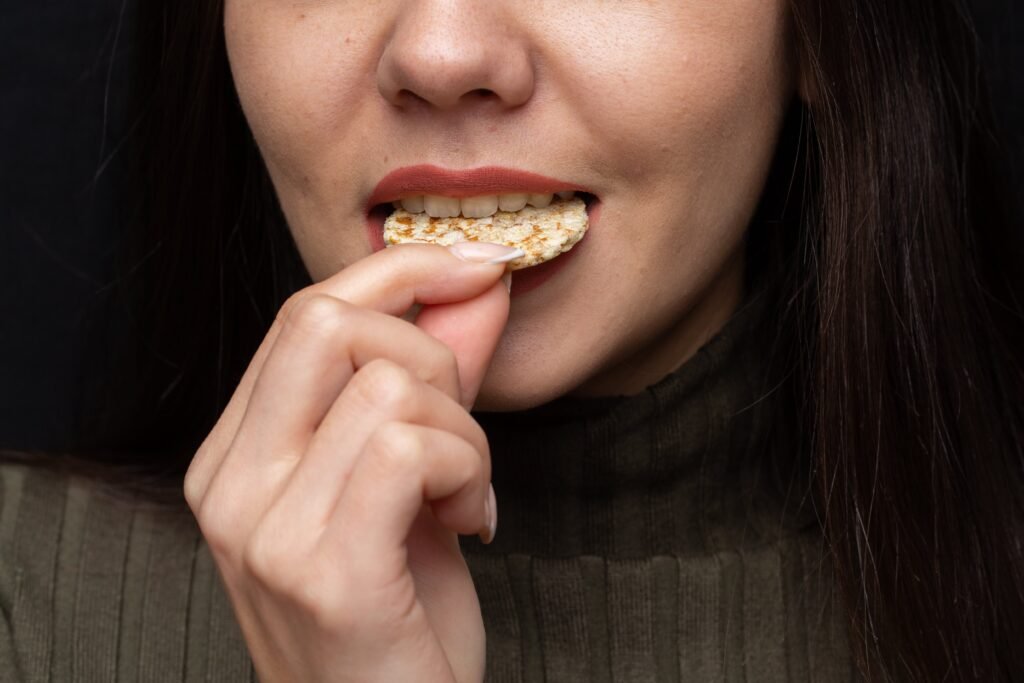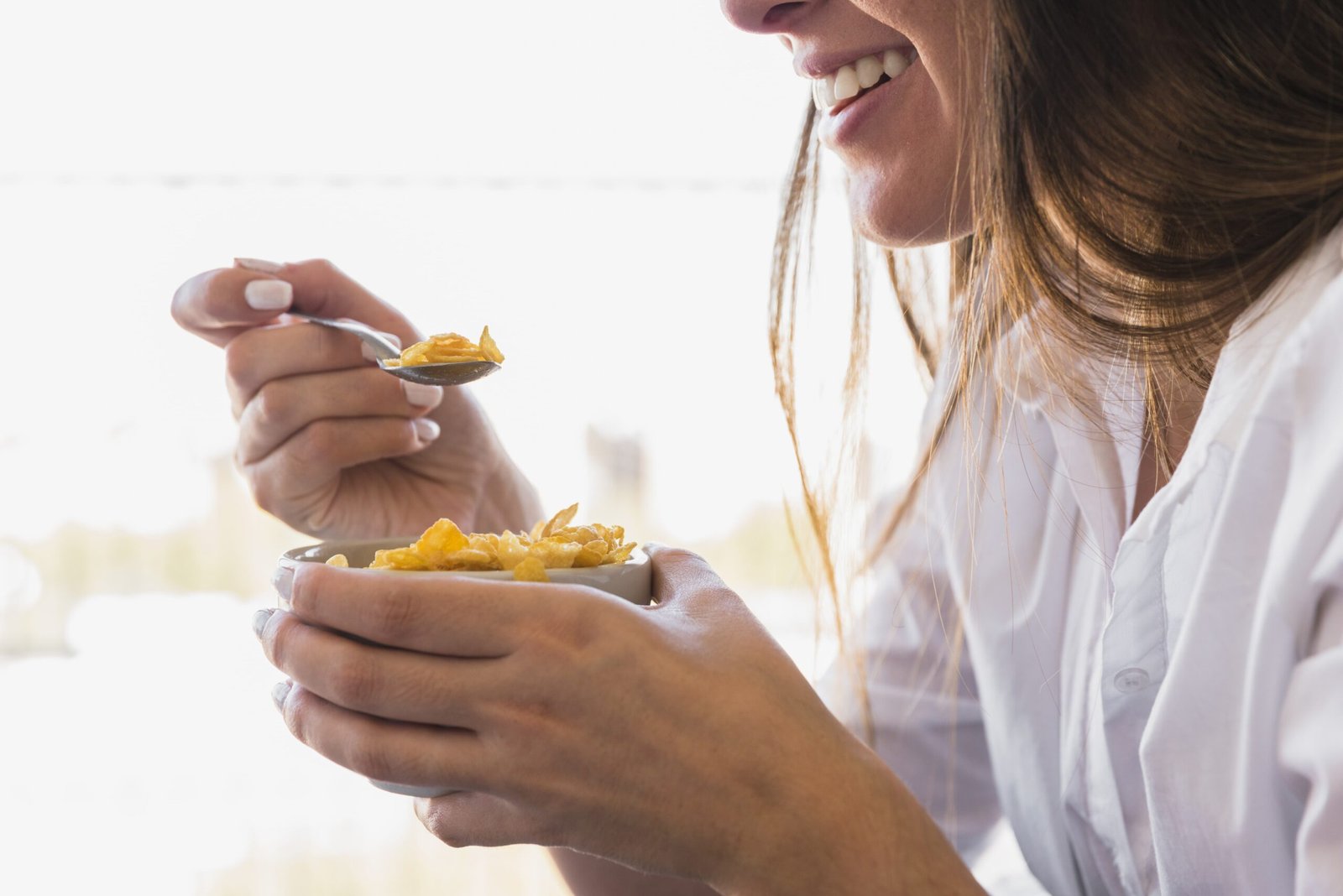Chewing your food thoroughly is one of the simplest yet most overlooked habits for achieving vibrant health. In a nation celebrated for its rich culinary heritage—from aloo parathas and idlis to dal-chawal and masala chai—the way we eat matters just as much as what we eat. The “32 chews” technique, rooted in ancient Ayurvedic wisdom, asks you to chew each bite at least 32 times before swallowing. Modern nutrition science now confirms that this mindful practice delivers profound chewing food benefits: improved digestion, better nutrient absorption, balanced blood sugar, weight management, and even a calmer mind.
In this comprehensive guide, you’ll find:
Table of Contents
1. Why 32 Chews? Bridging Ancient Wisdom and Modern Science

Long before nutrition labels and calorie counts, Ayurveda emphasized chewing as the gateway to good health. Our digestive fire—Agni—thrives when food is properly masticated, mixed thoroughly with saliva (rich in enzymes like amylase and lipase), and presented as a soft, uniform bolus to the stomach. Ancient texts such as the Charaka Samhita prescribe around 32 chews per bite, symbolizing a full cycle of mechanical and enzymatic breakdown.
Modern research underscores this wisdom:
- Glycemic Control: Slow, deliberate chewing can lower post-meal blood sugar spikes by up to 30%, essential for metabolic health and diabetes prevention.
- Reduced Caloric Intake: A 2017 study found that participants who chewed 30+ times consumed 12% fewer calories per meal on average¹.
- Enhanced Satiety Hormones: Thorough mastication signals the release of GLP-1 and PYY—hormones that promote fullness and curb overeating.
Together, these findings affirm that the benefits of chewing food 32 times extend well beyond mere digestion, impacting everything from appetite regulation to long-term metabolic wellness.
2. Top 12 Health Benefits of Thorough Mastication

| Benefit | Real-World Impact |
|---|---|
| 1. Improved Digestion | Reduced indigestion, less heartburn, lighter post-meal feeling. |
| 2. Enhanced Nutrient Uptake | Increased absorption of vitamins and minerals for sustained energy. |
| 3. Weight Management | Naturally lower calorie intake through heightened satiety. |
| 4. Stable Blood Sugar | Blunted glycemic spikes, better blood glucose control. |
| 5. Reduced Bloating & Gas | Smaller particles mean less fermentation by gut bacteria. |
| 6. Boosted Oral Health | More saliva neutralizes acids, protects enamel, reduces cavities. |
| 7. Stronger Jaw Muscles | Regular exercise for masseter muscles; improved facial tone. |
| 8. Better Metabolic Efficiency | Early digestive cues prime metabolism for nutrient processing. |
| 9. Mindful Eating & Stress Relief | Mealtime becomes a meditative practice, reducing stress. |
| 10. Enhanced Hydration | Saliva production upholds oral moisture and supports hydration. |
| 11. Balanced Appetite Hormones | Regulation of ghrelin and leptin leads to healthier eating patterns. |
| 12. Deepened Flavor Appreciation | Subtle tastes emerge, increasing meal satisfaction and joy. |
3. Mastering the 32 Chews Technique: A Deep Dive
Transitioning to 32 chews per bite might feel daunting, but by breaking it into clear phases and using adaptable strategies, it becomes both manageable and rewarding.
Portioning & Setting the Stage
- Ideal Bite Size:
- Aim for a piece roughly the size of a large grape or marble—small enough to chew 32 times without straining.
- Distraction-Free Environment:
- Turn off screens. Clear your table of unrelated items. Silence notifications.
- Place a small bowl of 32 lentils or beads beside your plate for tactile feedback.
- Pre-Bite Pause:
- Before each bite, close your eyes momentarily and inhale deeply. This micro-ritual shifts your brain into “eat” mode, priming digestion.
The Four-Phase Chewing Sequence
Divide each mouthful into four distinct mini-phases:
- Phase 1 – Placement & Awareness (Chews 1–4):
- Position food on your molars. Notice its texture—soft, crunchy, fibrous—before the first chew.
- Phase 2 – Mechanical Grinding (Chews 5–12):
- Focus on the back-and-forth motion. Feel the food breaking down into smaller fragments.
- Phase 3 – Enzymatic Mixing (Chews 13–24):
- Notice saliva pooling and softening the food. Enzymes start digesting starches and fats; flavors intensify in this window.
- Phase 4 – Purée Formation & Swallow Prep (Chews 25–32):
- By chew 30, the bite should resemble a smooth paste. If still coarse, add a couple more chews. Then gently guide the bolus toward the throat and swallow with awareness.
Counting Strategies
- Pebble Method: Move one pebble from a “to-do” to a “done” bowl per chew.
- Finger Taps: Tap your thumb to each fingertip in sequence; eight full cycles total 32 taps.
- Breath Counting: Inhale on count “1,” exhale on “2,” and continue alternating breaths until 32.
Adapting to Different Foods
- Thick Curries & Stews: Scoop well-separated portions so each bite has a uniform texture.
- Dense Breads & Flatbreads: Lightly wet or brush with chutney or sauce to soften initial chews.
- Crunchy Snacks & Chips: Pause halfway for a small sip of water to prevent jaw fatigue.
- Raw Fruits & Vegetables: Dice into very fine pieces—fibrous textures require smaller chunks to finish 32 chews comfortably.
Gradual Progression & Habit Tracking
- Week 1: Familiarization
- Practice at one meal daily, aiming for 16–20 chews per bite.
- Weeks 2–3: Building Momentum
- Increase to 24–28 chews at two meals. Notice fullness signals arriving earlier.
- Week 4: Solidification
- Hit 32 chews at your preferred meal—ideally a relaxed evening dinner.
- Beyond Week 4:
- Expand to all meals. Maintain a simple log—check marks, smiley faces, or a digital note work equally well.
Leveraging Technology & Community
- Timer Apps: Use gentle alarms to remind you to slow down at meal start.
- Habit Trackers: Record daily progress and celebrate streaks in apps like Streaks or Habitica.
- Social Accountability: Share quick “32-chews” updates on social media to inspire peers—and keep yourself motivated.
4. The Science Behind 32 Chews: How Thorough Mastication Impacts Your Body

Understanding the mechanisms at work can deepen your commitment to the practice. Here’s what each extra chew triggers:
Enzyme Activation & Early Digestion
- Salivary Amylase & Lipase Release: Each chew stimulates saliva production, releasing enzymes that begin breaking down carbohydrates and fats. Efficient pre-digestion reduces digestive workload by up to 15%.
- Bolus Formation: By the 25th–30th chew, food transforms into a uniform paste (bolus), easing its journey down the esophagus and into the stomach, minimizing reflux.
Glycemic Control & Hormonal Balance
- Blunted Blood Sugar Spikes: Thorough mastication slows carbohydrate delivery, leading to a 20–30% reduction in post-meal glucose peaks—vital for long-term metabolic health.
- Satiety Hormone Release: Research shows that chewing 30+ times elevates GLP-1 and PYY levels, promoting fullness and reducing overall calorie intake by 10–12%.
- Reduced Fermentable Load: Smaller particles reach the colon, leaving less matter for gas-producing bacteria—bloating and discomfort decrease by as much as 40%.
- Microbial Diversity: Emerging studies indicate that slower eating supports beneficial bacterial strains by moderating nutrient arrival rates.
Neural Feedback & Jaw Health
- Brain-Gut Axis Stimulation: The mechanical act of chewing activates the vagus nerve, bolstering parasympathetic (“rest-and-digest”) responses, lowering cortisol, and enhancing relaxation.
- Masticatory Muscle Exercise: Regular, repeated chewing strengthens jaw muscles, improving oral stability and reducing the risk of TMJ disorders.
5. Tracking Progress and Staying Motivated
Consistency is key. Use these practical strategies to monitor your journey and keep the momentum going:
- Chewing Journal:
- Note each meal’s estimated chew count, energy levels, and any digestive changes. A few lines per entry provide insightful data.
- Weekly Reflection:
- Every seven days, review your journal. Identify patterns: Which meals felt easiest? When did you notice reduced bloating or sustained energy? Use insights to fine-tune portions and timing.
- Gentle Reminders & Rewards:
- Set discrete alarms or calendar events for mealtime mindfulness. Celebrate a seven-day streak with a small non-food treat—perhaps a short nature walk or a favorite podcast episode.
- Accountability Partner:
- Pair up with a friend or family member. Exchange daily check-ins—“How many chews today?” Mutual encouragement makes the habit enjoyable.
- Reflective Prompt:
- After each meal, ask: “How do I feel now compared to before I started?” Tracking small victories—less gas, steadier focus, deeper satisfaction—fuels ongoing commitment.
6. Advanced Tips & Complementary Practices
Once the 32-chews habit feels natural, layer in these advanced strategies and rituals to amplify digestion, nutrient uptake, and overall well-being.
Optimizing Meal Composition
- Combine Macronutrients Thoughtfully: Pair protein with fiber-rich vegetables (e.g., grilled chicken with stir-fried greens) to slow gastric emptying and stabilize blood sugar.
- Embrace Fermented Foods: Add kimchi, sauerkraut, idli, or homemade yogurt to meals. Probiotics support a balanced microbiome and complement thorough chewing by providing live enzymes.
- Include Digestive Spices: A pinch of fennel, ajwain, or ginger in your dishes promotes enzyme secretion and eases gas formation.
Timing and Meal Sequencing
- Pre-Meal Ritual: Sip a small glass of warm water and lemon or herbal tea (peppermint, chamomile) 10–15 minutes before eating. This gently primes digestive secretions and hydrates tissues.
- Paced Courses: If enjoying multi-course meals, treat each course as its own mindful session—apply the 32-chew technique for appetizers, mains, and even dessert to sustain digestive momentum.
Integrating Movement and Posture
- Micro-Breaks Between Bites: Between every few bites, sit tall, roll shoulders back, and take a conscious breath. This maintains upright posture and optimal diaphragmatic function.
- Post-Meal Mobility: A gentle 5–10 minute walk or simple stretching sequence (neck rolls, side bends) helps regulate gastric motility and prevents blood from pooling in the digestive tract.
Mind–Body Practices
- Breath-Chew Synchronization: Coordinate each chew with a gentle inhalation or exhalation. This reinforces parasympathetic (rest-and-digest) activation via the vagus nerve.
- Gratitude Pause: After each bite, offer a brief moment of thanks—for the food’s origin, the hands that prepared it, and the nourishment it provides. Cultivating gratitude reduces stress hormones that can impair digestion.
Hydration Strategies
- Between-Bite Sips: Keep a small glass of room-temperature water at your side and take tiny sips after every 8–12 chews. This maintains saliva consistency without diluting gastric acids.
- Electrolyte Balance: Incorporate mineral-rich fluids—coconut water, buttermilk, or lightly salted water—to support digestive and metabolic processes, especially in hot climates or after vigorous activity.
Seasonal and Environmental Alignment
- Seasonal Foods & Temperatures: In warmer months, favor cooling produce (cucumbers, melons) and lighter preparations. In cooler seasons, enjoy warming root vegetables and broths to sustain Agni.
- Eating Environment: Where possible, dine in natural light or near greenery. Research shows that even visual contact with nature can reduce cortisol levels and enhance digestive efficiency.
By weaving these complementary practices into your routine—alongside the foundational 32-chews technique—you’ll cultivate a holistic framework for digestive resilience, energy balance, and mindful living that adapts seamlessly to any cuisine or lifestyle.
Conclusion: Bite-by-Bite Transformation
The “32 chews” technique is more than a digestive hack—it’s a pathway to mindful living, deeper flavor appreciation, and lasting wellness. From the earliest Ayurvedic insights to modern clinical findings, thorough mastication proves itself as a simple yet powerful tool. Start your journey one bite at a time, celebrate each extra chew, and watch how a small shift at the table ripples into every aspect of your health.
Take the 32-Chews Challenge today—experience the profound benefits of chewing food 32 times, and transform each meal into an opportunity for nourishment, presence, and joy.
FAQ (frequently asked questions)
Q1: What are the benefits of chewing food 32 times?
A: Chewing food 32 times improves digestion, boosts nutrient absorption, stabilizes blood sugar, aids weight management, and enhances oral health. This mindful eating practice activates digestive enzymes early and signals satiety hormones like GLP-1 and PYY for better appetite control.
Q2: How long does it take to chew food 32 times?
A: On average, chewing each bite 32 times adds about 10–15 seconds per bite, depending on food texture. While it extends mealtime slightly, users report overall faster digestion and reduced post-meal lethargy, making the extra seconds well worth it.
Q3: Is the 32 chews technique scientifically proven?
A: Yes—multiple clinical studies show that participants who chewed more than 30 times per bite consumed up to 12% fewer calories and experienced 20–30% lower postprandial blood glucose spikes, confirming the digestive and metabolic advantages.
Q4: Can chewing food 32 times help with weight loss?
A: Absolutely. The practice of chewing food thoroughly slows eating pace, increases fullness signals, and typically reduces total caloric intake by 10–15%. Combined with balanced nutrition, 32 chews per bite supports sustainable weight management.
Q5: How do I count 32 chews without losing track?
A: Use simple aids like moving a pebble per chew, tapping your thumb to fingers in cycles, or syncing chews with breath (inhale “1,” exhale “2”). These tactile or rhythmic methods ensure accurate chew counting.
Q6: What foods are easiest to start with for 32 chews?
A: Begin with softer, moist foods such as cooked vegetables, stews, yogurt, or rice. As you build jaw stamina, progress to firmer items like parathas, lean meats, and raw fruits, adjusting bite size to maintain comfort.
Q7: Will chewing slowly affect my productivity?
A: On the contrary, mindful eating often enhances focus and energy levels. By preventing digestive discomfort and post-meal crashes, the 32-chew habit can boost afternoon productivity and sustained mental clarity.
Q8: How soon will I notice benefits from chewing food 32 times?
A: Many people observe improved digestion, reduced bloating, and steadier energy within 3–5 days. Weight management and blood sugar control benefits typically emerge within 2–4 weeks of consistent practice.
Q9: Can children practice the 32 chews technique?
A: Yes—teaching kids to chew mindfully helps develop healthy eating habits early. Start with 16–20 chews and make it fun with counting games or colorful bead counters to engage young eaters.
Q10: Are there any risks to chewing food 32 times?
A: For most people, no risks exist. If you have TMJ issues or dental sensitivities, begin with fewer chews and softer foods, and consult a healthcare professional before progressing to higher counts.
